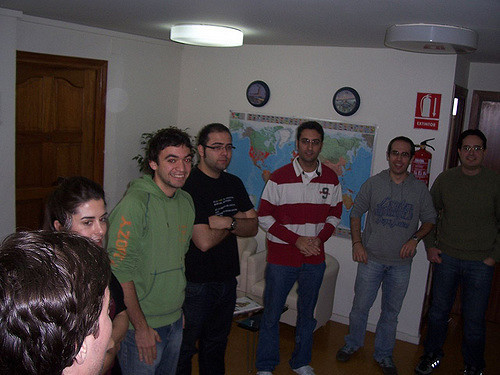Daily Standups
Overview

Teams participate in daily standup meetings, following the same ritual at the same times every week. These standups let everyone quickly know how well the team is moving toward the current sprint’s goals and focuses everyone on identifying impediments and assigning team members to address them.
-
Standups should take no more than 15 minutes to complete - less for a small team.
-
The goals are to keep the team informally focused on collaboration, communicaiton, and cadence.
-
Teams adjust their Task Boards as necessary during these meetings.
-
The Scrum Master ensures that the meeting discussion doesn’t go off on tangents.
Attendance
All team members (i.e. Developers, Scrum Master, and Product Manager) must be present except in emergency situations.
-
The daily standups schedule must be posted to the team norms in the team’s
CONTRIBUTING.md. Once posted, this schedule should be considered fixed and non-negotiable. -
Meetings must be held synchronously, except in emergency circumstances.
-
Stakeholders are welcome to observe, although this is not mandatory.
Ritual
The three questions
In a standup, each of the members of the team must quickly answer three questions:
- What did you do since the last standup, and is it finished?
- What are you working on now?
- What problems/blockers do you have, if any?
There should be nothing else discussed at these meetings, in order to keep them short.
How to address blocking problems
If a blocking problem can’t be solved internally by the team on the spot, the Scrum Master steps in and tries to resolve the blockage by the next meeting. If the Scrum Master is unable to do that, the product owner solicits help from outside the team.
Team problems
Anecdotal evidence suggests that the number one difficulty in student teams is that a lack of communication, which inevitably leads to poor performance. Daily standups are designed to address this directly.
There is no good reason why this should happen to you! Any team problem is going to directly affect your performance (and thus your grade). Synchronous attendance at these standups is critical. It is best to discuss any concerns that arise from teamwork directly with your team immediately at these meetings. If team issues remain unresolved more than two daily standups, relay these concerns directly to one of the Stakeholders (Professor and/or Tutors/Graders).
Synchronous
In-person standups
It is most desirable to hold in-person Standup meetings on a repeating schedule with all team members in attendance. Find a time every day thatworks best for your team and set a location. There are apps like when2meet and Doodle that are useful for scheduling times that work for everyone.
Remote standups
In cases where one or more team members is not able to attend the scheduled Standup in-person, provide an audio/video channel for the member(s) who are not able to be present in person. Do your Standup as you normally would, albeit with some member(s) virtually present.
Asynchronous standups
It is not uncommon for some team members to reside in different time zones. Teams should find times that work for everyone in these scenarios.
Attend standups asynchronously at your and your team’s own peril!
- In emergency cases where synchronous meetings are simply not possible, members may reply to the three standup questions at different times - an asynchronous standup.
- Asynchronous standups should not occur unless a member has an approved documented absence.
- Team members in the same time zone should attend the “asynchronous” standup synchronously with one another, even when other members are attending asynchronously.
- Such standups can be held in a virtual environment, such as Slack, Discord, or another chat system.
- An asynchronous standup is considered over after 24 hours. If any member has not participated within that time, they are considered absent from the standup.
Documentation
In practice, most standup meetings are informal and teams do not document what was said. However, in an educational setting, where developers are learning how to do things “properly” and managers/instructors need to be able to verify accuracy of developer/student adherence to protocol, documentation is critical.
For any given standup meeting, the Scrum Master must make a single post to the team’s standups messenger channel containing a summary of each team member’s answers to the three questions, e.g.
@foo_barstein (in-person, synchronous):
- did: Completed 95% unit testing code coverage of codebase
- doing: Implementing the Observer design pattern
- blocking: Nothing
@bar_bazburger (in-person, synchronous):
- did: Completed front-end code for the Registration and Login screens
- doing: Working on back-end for same
- blocking: Has an exam Thursday morning... can't do anything until after that
@foo_barstein (remote, asynchronous):
- did: Researched the Observer design pattern
- doing: Nothing... has a big organic chemistry lab report due Friday
- blocking: School work... will be free after Friday
@bum_biddlydoo (absent):
- did: ???
- doing: ???
- blocking: has disappeared and does not respond to messages... scrum master will notify management
Grading
A few notes
- All team members must attend “daily” standups at least 3 times per week, with at least 2 of these occurring on weekdays.
- None can be attended asynchronously, except in extreme circumstances, with notification to the entire team and stakeholders.
- There is no reason a team member should ever entirely miss a standup except in extreme emergencies.
Sources
Videos
- Having daily stand-up meetings
- Pitfall: Reporting status at standups
- Agile Simulation - Part 20 | The Daily Standup | Agile Videos
- Identify the project stakeholders